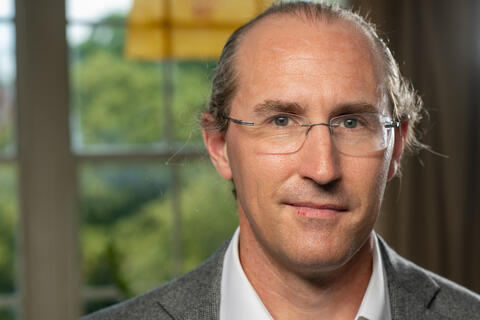
Ohio University Press Release:
Ohio University Professor of Physiology and Executive Director of the Ohio Musculoskeletal and Neurological Institute (OMNI) Brian Clark Ph.D. was one of 40 expert leaders in the field of aging from around the world chosen to present at a workshop hosted by the National Institute of Health’s (NIH) National Institute on Aging (NIA) on the development of function promoting therapies for age-related weakness. Clark was also asked by the NIH to publish a comprehensive review of his research over the past decade in the Journal of Gerontology.
The workshop covered a variety of topics including advances in muscle biology, novel candidate molecules, findings from randomized trials, and challenges in the design of clinical trials and regulatory approval of function-promoting therapies.
“It’s always an honor to give a talk at this type of workshop and major meeting such as this,” Clark said. “You cherish these moments because you have put your life into this research and are able to capture an audience of key people working in the same discipline. Sharing my knowledge and findings on this type of platform also allows for a broader impact and critical discussions to take place.”
During the workshop, Clark spoke about his research on the role of the nervous system in age-related muscle weakness and participated on a panel discussion about the correlation between neural mechanisms and age-related loss of muscle strength.
Much of what he spoke about during the workshop was also included in the article in the Journal of Gerontology which detailed his work evaluating the putative neural mechanisms of age-related muscle weakness, promoting therapies for age-related mobility limitations.
The article also discusses the evolving definition of sarcopenia, or the gradual loss of muscle mass, strength, and function, and its primary defining characteristic – weakness. The review article explores the premise that impairments in the nervous system’s ability to generate maximal force of power contribute to sarcopenia.
“Understanding the causes of age-related losses of physical function has implications to both patients, in relation to improved health, physical capacity, quality of life and more, as well as society at large, as there are a large number of older adults who require assistance with daily tasks due to weakness,” Clark said. “By understanding the causes of weakness and physical function loss we can develop rationale therapeutic strategies.”
Clark added that some therapeutic strategies include the development of therapeutic compounds, nutraceuticals and supplements, diet and exercise. He explained that to improve strength and function, we must first understand what causes weakness.
According to Clark, when he was a graduate student more than 25 years ago and first getting into this field of study, it was largely assumed that age-related weakness and loss of mobility were due to a person’s muscles wasting away. That despite best efforts, weakness was just a part of aging. However, after years of research, Clark has found that age-related weakness is also related to the nervous system changes and the physical performance of muscles.
“Muscles are puppets being moved by the nervous system,” Clark explained. “We have found robust evidence in our lab showing how age-related changes happen due to how well the brain signals move the muscles to work or in how well the muscles act on that signal."
According to Clark, the specific neural mechanisms appear to be linked to low level nerve cell excitability, impaired ability to transmit action potentials/electrical signals between the nerves and the muscles, as well as reduced integrity of brain networks involved in performing relatively automatic motor tasks, such as walking.
The findings from Clark’s lab identifies some potential therapeutic targets, as well as helps to underscore the need for exercise and physical to maintain muscle strength and function with aging. In particular, resistance exercises that strengthen muscles and tasks and exercises that challenge motor control, such as dancing, are vitally important.
“Our work has consistently indicated that changes in the nervous system are a key culprit and likely account for about a third of the weakness seen in aging, in addition to the loss of muscle mass and quality,” Clark said.
Assisting Clark in his research are a vast network of collaborators from over the years, including students and colleagues at OHIO. In particular, Clark notes that his wife, Leatha Clark who holds degrees in engineering mechanics as well as a Doctor in Physical Therapy, has been integral to the work done his lab. He also notes that Todd Manini, a professor at the University of Florida, who he has worked with since they were graduate students together at Syracuse University, and who happens to be an OHIO alumni (BS ’97, Biological Sciences), is a critical collaborator of his. More recently, Clark notes that he has developed a very robust and strong collaboration with Dave Arnold, M.D., executive director of the NextGen Precision Health initiative at the University of Missouri.
Currently, Clark, who is also the Osteopathic Heritage Foundation Harold E. Clybourne, D.O., Endowed Research Chair, is working to identify the role of the motor neuron, the final neuron that connects the nervous system with the muscle, in health and disease. He is also working to develop novel tools for diagnosing sarcopenia and osteoporosis. These projects are funded by around $10 million in grants from the NIH.
